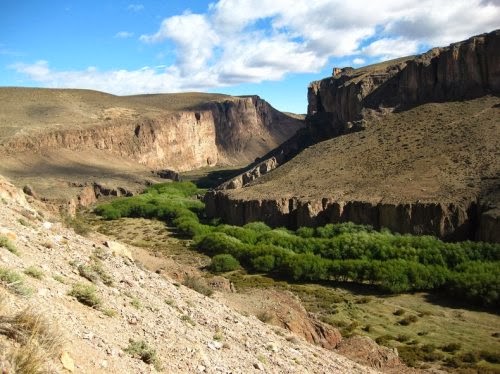Prehistoric cave paintings, prints and hand stencils can be found on all continents. They began to appear on the stone walls around the world, at least 30,000 years ago. However, the Cueva de las Manos in Patagonia contains exceptionally diverse collection of rock art.
Cueva de las Manos, which literally means "Cave of Hands" is located in the valley of the Pinturas (Río Pinturas), in the province of Santa Cruz (Santa Cruz), Argentina, 163 kilometers to the south of the town of Perito Moreno (Perito Moreno). The cave got its name from a cluster of silhouettes of human hands, which could be seen on the walls of the cave. These rock carvings were made by communities of hunter-gatherers who lived here about 13 000 - 9500 years ago. This age was determined on the basis of skeletal remains of tubes that have been used to spray paint on the wall of the cave to create silhouettes of hands.
The cave entrance is obscured by a stone wall covered with numerous silhouettes of hands. Many silhouettes of prints are left hands, which means that artists, spray paint, holding a tube of paint in his right hand. In the cave there are five clusters of rock art, shapes and motifs drawn later, often superimposed on those that were made in earlier periods. The pictures were taken with a natural mineral pigments - iron oxide for red and purple, kaolin for white natroyarozit for yellow, and manganese oxide for the black color. These substances are pulverized and mixed with a binder, the nature of which is unknown.
In addition to the handprints, there are images of people and animals, such as guanacos, rheas, and felines, as well as drawings of geometric shapes, zigzag patterns, representations of the sun, and a few scenes of hunting. Hunting scenes depict various hunting strategies that surround the animal, caught in an ambush or attack, using projectile weapons, round stones known as bolas. In some scenes show the individual hunters, and in other groups of hunters, consisting of ten or more men.
The drawings belong to three different cultures. The first human groups were hunters, held long distances in search of prey, no way was the guanaco. The second level of culture can be attributed to around 7000 BC, according to the silhouette of hands. During this period, did not appear images of hunting scenes. There also are some examples of silhouettes paws American ostrich (rhea). This culture lasted until about 3300 BC, when art became more schematic and included a highly stylized zoomorphic and anthropomorphic figures.
The final cultural period began about 1300 BC. The art of this period differed bright red pigments concentrated on abstract geometric shapes, as well as the rather schematic representations of animals and humans. It is believed that this was the work of the people of the historic hunter-gatherers Tehuelche (Tehuelche), who inhabited a vast area of Patagonia, at the time when the Spanish arrived early traders and settlers. It was the creation of huge ranch for breeding cattle, put an end to their way of life.












